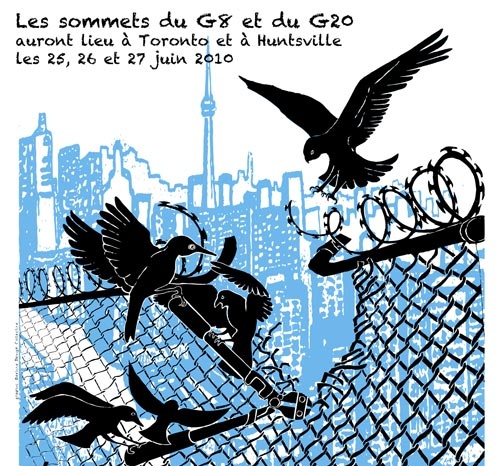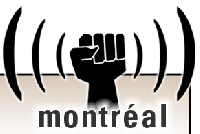 |
 |
 |
 |
 |
 |
|
 |
 |
 |
 |
 |
 |
 |
Régions du Québec |  |
 |
 |
|
 |
 |
|
 |
 |
|
 |
 |
 |
 |
 |
 |
Rubriques (sujets) |  |
 |
 |
|
 |
 |
|
 |
|
 |
 |
 |
Ibdaa is the Intifada
http://aaron.resist.ca/?q=node/22
Ibdaa is the Intifada
By Aaron Lakoff
January 12th, 2005 – Dheisheh refugee camp, Bethlehem
If I had my head pressed hard under a gun, shivering, and praying for my life, what would I do? Where could I find hope? Could I find strength? I think I would give in. And I would think that giving in would be the only human reaction. But today in Bethlehem, I was proven wrong. Today in Bethlehem, I was inspired by people under that gun.
http://aaron.resist.ca/?q=node/22
By Aaron Lakoff
January 12th, 2005 – Dheisheh refugee camp, Bethlehem
If I had my head pressed hard under a gun, shivering, and praying for my life, what would I do? Where could I find hope? Could I find strength? I think I would give in. And I would think that giving in would be the only human reaction. But today in Bethlehem, I was proven wrong. Today in Bethlehem, I was inspired by people under that gun.
Our taxi driver dropped us off at the Ibdaa cultural center, which sits just on the edge of the Dheisheh refugee camp. But you wouldn’t notice it was a camp right away. Like many things under the occupation, the signs are somewhat subtle.
I want to write about Ibdaa because I feel compelled to. I feel that the world needs to know about the existence of this place.
The residents of the camp certainly need this place acknowledged. The kids who are serving as our guides for the afternoon tell us that a few years ago, the children and residents of the camp were skeptical and cold to Westerners coming into the camp with cameras and recorders, but after years of the Intifada and desperation, they see it as beneficial and necessary for the eyes of the world to be here.
But back to Ibdaa. We enter the building, and my friend Izzy and I are immediately taken aback by the powerful murals in the stairwell depicting the Palestinian culture and resistance to the occupation.
As is the custom here, we are warmly received in the tea room by Ziad Abbas, the co-director of the center. Even though he is clearly a busy man, he makes time for us, and we hadn’t even set up an appointment.
We sit down over tea with Ziad, and he starts explaining the center, listing off all of Ibdaa’s activities. A health clinic, radio station, TV station, dance troupe, basketball teams, leadership groups, arts workshops – he goes on for minutes, barely stopping for air. We can’t believe this place! Aren’t people in refugee camps under occupation supposed to be living in misery and sadness? This place is truly a beacon of light.
Ziad calls two teenage boys over to our table. They are both involved in the leadership program at Ibdaa. Nor, one of the boys, will be our guide through the camp. He tells us he’s been living here his whole life and that his father was shot dead by the Israeli army at a checkpoint outside the city. We ask him if the tour will cost money, and he looks at us as if we’re crazy. This boy has lived through so much, yet his humility is overwhelming.
At times wandering through the camp with them, I almost feel like I’m in old Jerusalem with its winding and narrow streets, and strange plant growth emerging through the concrete. But this place is no Jerusalem, and it is far away from tourist eyes.
All of the sudden, it really hits me that we’re in a refugee camp. Rubble and crooked steel beams are everywhere. Children no older than four are playing in it. You can feel the density here, and it is no surprise that 12,000 people live in 1km square. Since there is no room for refugees to build out, they build up. Everyone lives on top of each other.
You can also see signs of the Intifada everywhere here – from the graffiti that covers every single wall, to the stenciled pictures of the martyrs (and Dheisheh has had many during the Al-Aqsa Intifada), to the buildings bombed by the Israeli Defense Forces (IDF). We learn that one building blown up by the Israeli army this past December/04 was home to the kindergarten program for Ibdaa.
It is here that Ahmed, another 17-year old Palestinian on the tour with us, tells me something that will stick with me forever. I ask him what the youth of the camp do to oppose the occupation, expecting an answer like throwing stones or taking up arms. No. Instead, he tells me this:
“There are two ways I oppose the occupation here. One is that I study and try to keep learning. The other is through Ibdaa and the activities I do there like the dance troupe. I can’t let the occupation ruin my life.
 |
 |
 |
 |
Dossier G20 |  |
 |
 |
|
 |
 |
|
 |
Nous vous offrons plusieurs reportages indépendants et témoignages...

Liste des activités lors de ce « contre-sommet » à Toronto Vous pouvez aussi visiter ces médias alternatifs anglophones... Centre des médias Alternatifs Toronto 2010.mediacoop.net Media Co-op Toronto http://toronto.mediacoop.ca Toronto Community Mobilization www.attacktheroots.net (en Anglais) |
 |
 |
 |
 |
 |
 |
 |
CMAQ: Vie associative |  |
 |
 |
|
 |
 |
|
 |
 Collectif à Québec: n'existe plus. Impliquez-vous ! |
 |
 |
 |
 |
 |
 |
 |
 |
|
 |
 |
 |
Ceci est un média alternatif de publication ouverte. Le collectif CMAQ, qui gère la validation des contributions sur le Indymedia-Québec, n'endosse aucunement les propos et ne juge pas de la véracité des informations. Ce sont les commentaires des Internautes, comme vous, qui servent à évaluer la qualité de l'information. Nous avons néanmoins une
Politique éditoriale
, qui essentiellement demande que les contributions portent sur une question d'émancipation et ne proviennent pas de médias commerciaux.
This is an alternative media using open publishing. The CMAQ collective, who validates the posts submitted on the Indymedia-Quebec, does not endorse in any way the opinions and statements and does not judge if the information is correct or true. The quality of the information is evaluated by the comments from Internet surfers, like yourself. We nonetheless have an
Editorial Policy
, which essentially requires that posts be related to questions of emancipation and does not come from a commercial media.


